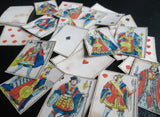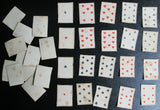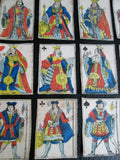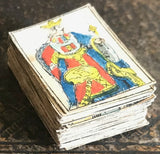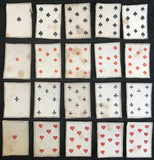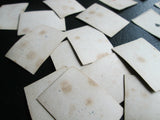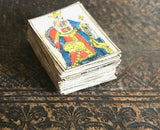c.1800 Miniature Napoleonic Dutch Centprints
32/32 cards complete, incredibly rare paper cards with hand-painted Paris pattern stencils
Miniature Card Dimensions: 3.3 cm X 2.4 cm
DESCRIPTION:
c.1800 Miniature Napoleonic Dutch Centprints
32/32 cards complete
Rare paper cards with hand-painted Paris pattern stencils
Miniature cards appear to be from a centprint-sheet and are matching to the style of cards produced during the 1st Napoleonic Empire of 1800 with French suit markers. These miniature centprints or catchpenny print cards have standing court royals, one-way pips and no indices. Hand-painted in the usual style of Dutch centprint makers. Paris pattern court designs of early 1800s. The designs are an early variant of the 'Paris' pattern which had spread to the Low Countries from Northern France. All of the cards have a blank white reverse.
“For centuries catchpenny prints served both as books and newspapers for large sections of the population. Many catchpenny prints have disappeared forever; they were ‘used up’ by children and adults. Libraries did not actively collect them, but thanks to private collectors interesting collections have remained accessible for study and research.” Catchpenny prints are considered a precursor to the modern comic strip, where images were used to tell stories portrayed in 8, 16, 24, or even 48 different scene.
To read more about the history of catchpenny prints, see the collection at Koninklijke Bibliotheek:
https://geheugen.delpher.nl/en/geheugen/pages/collectie/Centsprenten+van+de+Koninklijke+Bibliotheek
“Dutch centprints, or catchpenny prints, were printed on cheap paper of a slightly larger size than the modern A3-format and contained one or more illustrations, generally accompanied by a brief text. The catchpenny prints were often sloppily coloured sometimes with orange or purple-red and blue, sometimes with yellow, painted with an informal style, applied with a coarse brush, thumbprint, or shifted template, and they were especially geared to a public with little purchasing power. In the past they have also been called children’s prints, popular prints, ‘oortjes’ prints (in Dutch money, an oortje was a cent and a quarter), saints or ‘mannekesblaren’ (in Dutch: little fellows’ leaves). The term ‘catchpenny prints’ emphasizes an economic aspect: for a long time, catchpenny prints were the cheapest illustrated printed material in the Netherlands.”
|
CONDITION: Moderate signs of use; there aren't any tears or rips of any kind; there are no creases, and all of the pennyprint cards have a few signs of stains on the blank reverses, with the appearance of minor stains and splotchy discolouration on the painted surfaces of the fragile, parchment-like, paper card-stock; the box is in more or less mint condition. |









